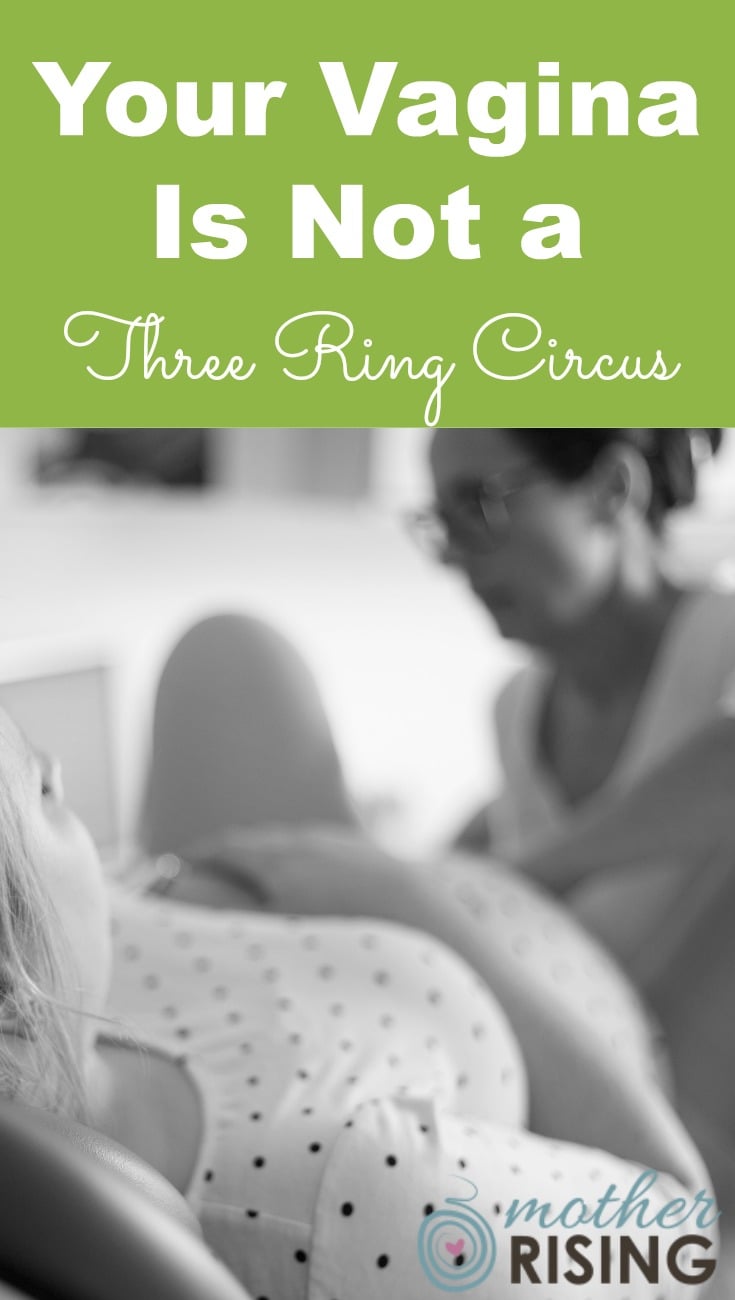A three ring circus can be described as a situation of confusion, characterized by a bewildering variety of events or activities. A vagina can be described in many ways, but a situation of confusion? Chaotic and busy? May it never be.

Some of the most upsetting births to witness and experience happen when women have no awareness of their care provider’s choices and therefore have little to no input in decision making in regards to their care. People are coming and going, multiple medical procedures take place and devices are inserted in the vagina, all in the name of a healthy mother and baby.
These upsetting births are caused in part by a lack of education in new parents but also a model of care that is neither mother or baby centered.
In this post I hope to pursue a shift in thinking that encourages women to have an active role in their healthcare but also shed light on common interventions that sometimes make a perfectly good birth become a three ring circus.
Because your vagina is not a three ring circus.
WARNING: This post may be triggering for some who have had a previous traumatic birth experience. Proceed with caution.

Your Vagina Is Not a Three Ring Circus
In life, many things are out of our control. For example, we have no control over what other people say or what other people do. We absolutely have influence over certain people, but often times things are simply out of our control.
On the other hand, there are a few things that are “our property” that we have more control over and have final say with. One of these things is our body, what is done or not done to it, and the choices we make in regards to our health and wellness.
Medical doctors are experts in a specialized field of their choosing. Obstetricians specialize in pregnancy, childbirth and postpartum. OBs are excellent surgeons and man, am I grateful for them.
However, problems arise when doctors (and other care providers) operate as the experts of their patient’s bodies, don’t encourage collaboration, and exercise final say over their choices. Some women appreciate this medical model of care, but many women feel the opposite and want to fire their OB. Feelings of confusion, frustration, conflict, anger, and anxiety sometimes manifest when these inherent boundaries are violated.
I prefer a more mother and baby centered model of care. This dynamic is one of collaboration, trust, informed consent and is a true partnership. Rather than a dynamic of authority and obedience, it is a relationship of mutuality where both parties take responsibility for a healthy outcome.
Satisfaction Matters
Research has shown that the more a woman is part of the decision-making process during birth, she will be happier about the outcome, no matter what happens.
“It is also suggested that active involvement of pregnant woman in decision-making process for the delivery method will increase the rate of vaginal birth after c-section and decrease c-section rate and improve the degree of maternal satisfaction after delivery.”
Plain and simple, if a woman is ignored she will be unhappy about her experience giving birth, which can have long lasting consequences in the way she mothers, her self-esteem and future pregnancies (among other things).
Communicating with care providers is a two way street and sometimes both parties lack the skills to come to the desired outcome. Use this post for a step by step tutorial on how to ask questions and get good information in order to make the best decision for each individual.
Common Problematic (Three Ring Circus) Interventions
The following are routine interventions that sometimes lead to a more chaotic, dissatisfying birth experience. In no way am I stating that these interventions are unnecessary, but perhaps instead of categorizing such interventions as unnecessary or necessary, we could move more towards language that says “is this the right intervention for me and my baby?“.
Frequent Vaginal Exams
One of the first interventions a woman experiences in labor is a vaginal exam. A vaginal exam can be helpful for the entire birth team to determine how much labor progress a woman has made and can sometimes help make an educated guess about what lies ahead.
However, I’ve been at my fair share of births and have concluded that the vagina is not a crystal ball and cannot predict the future but only report on what has already happened.
Also, frequent vaginal exams increase the risk of infection in mother and baby during labor.
Because of this, it is wise to limit the use of vaginal exams only when necessary and helpful for the mother and her birth team. Too many vaginal exams can encourage a three ring circus birth experience.

Artificial Rupture of Membranes
Another routine intervention that can sometimes turn a perfectly good birth into a three ring circus is the artificial rupture of membranes (AROM) aka “breaking the water”. AROM can be used to speed up and even induce labor.
I’ve requested my water to be broken at two of my births (first birth story here and second birth story here) and things definitely sped up after my water broke.
However, I’ve also experienced the opposite effect with the birth of my third child. My water broke spontaneously but I didn’t immediately go into labor. After “trying all the things”, I eventually chose to use Pitocin to get labor going. Since after the rupture of membranes, the risk of infection steadily increases as time goes on without giving birth, Pitocin was the right choice for me.
Don’t get me wrong, I am actually a huge fan of AROM for helping me “turn the corner” in birth and get closer to pushing. But just because it worked for me, doesn’t mean it’s the right choice for you.
AROM carries the risk of it not accomplishing its desired effect and therefore making an infection more likely. Infection during labor is absolutely something to be avoided. The artificial rupture of membranes could potentially encourage the beginning of a three ring circus birth experience.
Uninvited or Unwished for Observers
An overlooked aspect of birth that could potentially turn a perfectly good birth into a three ring circus is uninvited or unwished for observers or attendees. These people may be residents, students, friends and family members or a care provider that shows up in another’s stead.
For someone that’s never witnessed the natural unfolding of birth, this may seem like a no big deal sort of thing, but believe it or not, having the wrong people in a birth room can slow down or even stop a labor.
For those that have difficulty imagining this unfold, picture what would happen if you opened the closet door where your neighbor’s dog was having its puppies. What would this mama dog do? She would likely stop being in labor long enough to move locations to a spot where she was away from intruders and felt more safe.
Generally speaking, attending a birth should be by invitation only. If not, there’s always a chance that the surprise guest could turn a perfectly good birth into a three ring circus.

Perineal Massage
I’ve witnessed many less than ideal things unfold at births – excessive monitoring, tense and fearful energy, belittling or condescending attitudes from family members or care providers, etc. For the most part I don’t take any of that home with me – not my circus, not my monkeys.
However, there are a few things that agitate me quite a bit and one of them is “perineal massage” during pushing.
Perineal massage is the pre-emptive stretching of the perineum in hopes to decrease tearing during birth. Sounds like a good thing, right? Parents are surprised to learn that perineal massage is a mistake that doesn’t actually prevent tearing.
Perineal massage begins when a care provider sits at the bottom of the hospital bed or on a stool, gowned up and with gloves on. With lubricating jelly on the fingers they place two lubricated fingers in the vagina and push down and to the sides while mom is pushing AND not pushing. This procedure is done over and over again throughout the entire pushing experience.
From an outsider’s perspective, perineal massage looks invasive, distracting, and uncomfortable, if not painful. Ironically, many mother’s perineums begin to swell during this “massage”.
The most baffling thing I’ve observed is that according to the OBs at my local hospital, first time mothers, on average, will get a second degree tear. If this is the case, I wonder why they even bother with perineal massage. What’s the point? It’s clearly not accomplishing a lower incidence of tearing.
Curious about what the evidence says about perineal massage? I sure hope so.
Turns out that the evidence agrees with my observations that perineal massage during pushing has little effect. And that being “hands on” (aka actively slowing, holding, stretching, pushing) shows an increase in tearing, episiotomy and postpartum perineal pain.
Perineal massage, albeit extremely common, can be the grand finale of a three ring circus birth.
(For more information about how to prevent tearing at birth make sure you read this post.)

More Common Problematic (Three Ring Circus) Interventions
If you have found this blog post to be insightful, there’s a good chance more information is desired about what else could potentially make a perfectly good birth turn into a three ring circus. The following is a non-exhaustive list of medical devices, medications and procedures that have their place but are sometimes overused at births.
Medical Devices and Medications That Go in the Uterus
Cervadil
Cervadil is a medication that is used to soften and ripen the cervix (much like the work of early labor) in preparation for an induction. It is placed in the cervix, often overnight. Sometimes it actually jumpstarts labor by causing contractions, sometimes it doesn’t work at all and sometimes it has the desired effect – a cervix ready for labor.
Foley Bulb Catheter
A foley bulb catheter is a device that manually dilates the cervix to around three centimeters. While deflated it is inserted through the cervix and then filled with saline solution which puts manual pressure on the cervix causing it to dilate. Some women appreciate this method of induction because it doesn’t involve any medications. However, just with any method of induction, sometimes it works and sometimes it doesn’t.
Intrauterine Pressure Catheter
An intrauterine pressure catheter is a device placed in the uterus next to the baby that measures the strength of contractions. The external belly monitor measures if contractions are happening or not, while an internal uterine catheter actually determines the intensity of each. For this device to be inserted the amniotic sac has to be ruptured (AROM) if it has not already done so.
Internal Fetal Monitor
An internal fetal monitor is a device that gives an accurate measurement of the baby’s heartbeat. This is different than the external fetal monitor. Instead of using an ultrasound doppler, which can sometimes be unreliable, an electrode is placed in the baby’s scalp and therefore gives a precise heart rate. Just like the intrauterine pressure catheter, this device can only be used after AROM.
Medical Devices and Procedures at the Vulva and Perineum
Urinary Catheter
A urinary catheter at birth is mainly used when a woman in labor receives an epidural. When the catheter is placed she is typically numb and can’t feel anything. Just like an unmedicated birth, having an empty bladder helps encourage labor progress.
Episiotomy
An episiotomy is a cut made to the perineum to allow for a faster delivery of baby. I have seen this technique used to save a few babies’ lives because an episiotomy makes birth happen NOW. Normally, however, it’s best to be patient and allow the time needed for the perineum to stretch on its own. Hopefully tearing can be avoided, but even it doesn’t, natural tearing heals significantly better than an episiotomy.
Forceps
Forceps are used to manually pull a baby from the mother’s pelvis through the vagina. They kinda look like jumbo salad tongs. An episiotomy is required for this procedure. Injury in mother and/or baby often occurs with this type of vaginal assisted delivery.
In my community forceps aren’t used, but from what I’ve heard they are more likely to be used in teaching hospitals.
Vacuum Extraction
A vacuum extraction, however, is used in my community. A vacuum is a more gentle method of vaginal assisted delivery and is sometimes used as a last resort before a cesarean birth. Even though it’s more gentle than forceps, there is still a very good chance of injury to mother and baby. Baby may have a raised bruise on its head and women may experience more bruising, swelling, and tearing.
Your Vagina Is Not a Three Ring Circus
In the right context, a three ring circus can be an enjoyable, diverting activity – for the whole family! However, the vagina (and birth) should be the least likely place to find such hustle, bustle and chaos.
I hope that through better education and a shift from the medical model of care to where both parties take responsibility for a healthy outcome will lead to births (and vaginas!) that are more safe, healthy and satisfying.
Your vagina is not a three ring circus!

Resources
For more in depth reading about the procedures listed above and the research behind them, an excellent resource is The Thinking Woman’s Guide to a Better Birth by Henci Goer.
Another excellent read is The Birth Partner by Penny Simkin, which also gives great information about these interventions, but also discusses how to support a woman through them.
For more thought provoking reading, check out this great list of the best pregnancy books.
Leave a Comment
I’d love to hear from you! Leave a comment and let me know your thoughts about this article.
What stood out most to you? What do you know now that you didn’t before?
